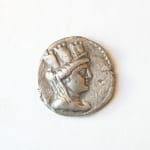Phoenician Silver Tetradrachm of Arados, 2 Century BCE - 1st Century BCE
Silver
height 2.5 cm
height 1 in
height 1 in
C.7665
Obverse, turreted and draped bust of Tyche in right profile; pellet-border; reverse, ?????O?, right; ???, Phoenician letter and ?C, left; Nike advancing left, holding palm date and aphlaston; within laurel-wreath....
Obverse, turreted and draped bust of Tyche in right profile; pellet-border; reverse, ?????O?, right; ???, Phoenician letter and ?C, left; Nike advancing left, holding palm date and aphlaston; within laurel-wreath.
The tetradrachm – a silver coin equivalent to four drachmae – first came into circulation in Athens in 510 BC. It became the most authoritative coinage of Classical Greece and was soon adopted by many other city-states of ancient Greece.
Arados was an important city of northern Phoenicia. While, occupying only an island it controlled an extensive area on the mainland. A suitable patron came naturally in the form of the tutelary divinity Tyche who embodied the destiny of a city, bringing fortune and prosperity. She is typically depicted wearing a mural crown, a headpiece that represents the city walls or towers.
Nike, on the reverse, was the Greek goddess of victory. She is typically portrayed as a winged, draped female holding palm date. The aphlaston, the curved stern of a ship alludes to naval warfare, which had played a vital role in the development of many ancient empires and city-states. The importance of naval operations, especially for an island, led to many representations on coinage.
The tetradrachm – a silver coin equivalent to four drachmae – first came into circulation in Athens in 510 BC. It became the most authoritative coinage of Classical Greece and was soon adopted by many other city-states of ancient Greece.
Arados was an important city of northern Phoenicia. While, occupying only an island it controlled an extensive area on the mainland. A suitable patron came naturally in the form of the tutelary divinity Tyche who embodied the destiny of a city, bringing fortune and prosperity. She is typically depicted wearing a mural crown, a headpiece that represents the city walls or towers.
Nike, on the reverse, was the Greek goddess of victory. She is typically portrayed as a winged, draped female holding palm date. The aphlaston, the curved stern of a ship alludes to naval warfare, which had played a vital role in the development of many ancient empires and city-states. The importance of naval operations, especially for an island, led to many representations on coinage.



